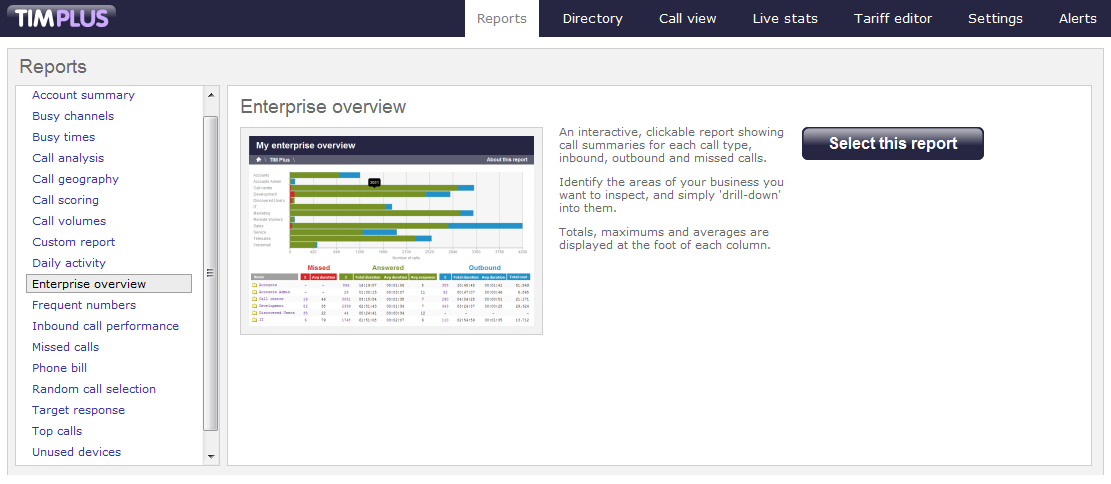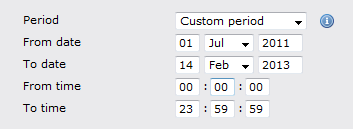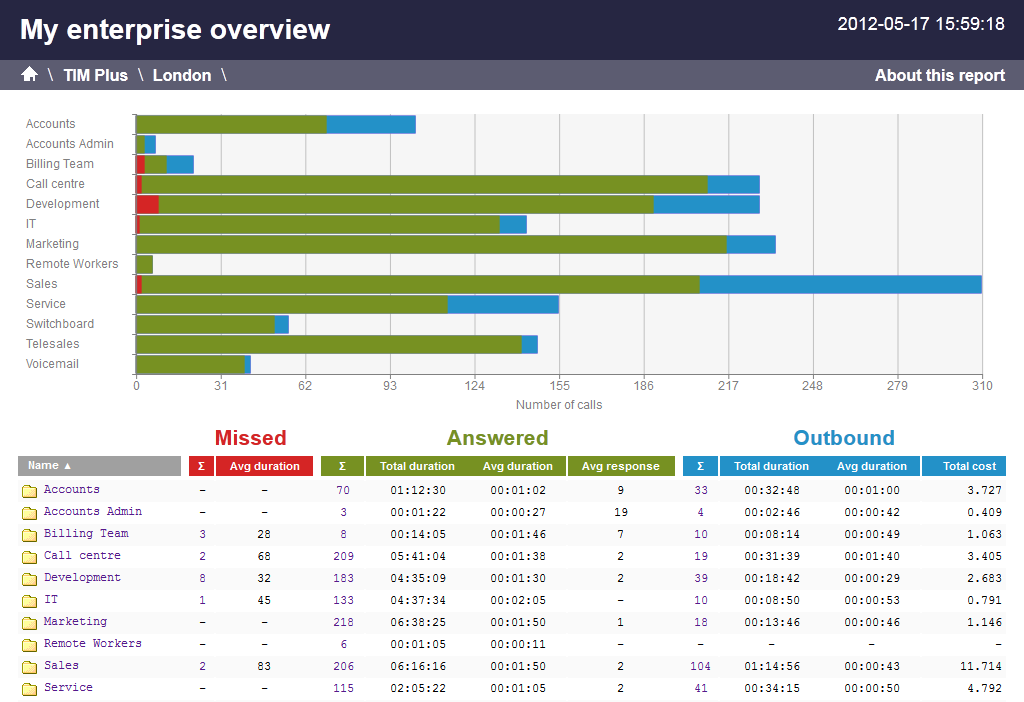The Enterprise Overview report
Introduction
The Enterprise overview report is an interactive, click-able report offering a complete summary of all call types for all sites or extension groups. The report allows you to start a the top directory level and drill-down into them to see the call summary information for each subgroup or extension. Totals, maximums and averages are displayed at the foot of each column.

Running the report
On the Reports screen, click on Enterprise Overview in the reports list and then press the button.

A new window will appear, where you can select the criteria for your report.
Selecting the reporting period
Every report requires a period to run over. This is generally defined as the "Reporting period".

There are several preset periods that can be selected from a drop-down list. The predefined periods are based on a standard Gregorian calendar and are defined as follows:
| Period | Description |
|---|---|
| Today | The start and end dates are set to the current date. The start time is set to 00:00:00 and the end time to 23:59:59. |
| Yesterday | The start and end dates are set to the current date minus one day. The start time is set to 00:00:00 and the end time to 23:59:59. |
| This week | The start date is set to the first day (normally Monday) of the current week. The end date is set to the current day. The start time is set to 00:00:00 and the end time to the current time. |
| Last week | The start date is set to the date of the last Monday, and the end date is set to the start date plus seven days. The start time is set to 00:00:00 and the end time to 23:59:59. |
| This month | The start date is set to the first day of the current month. The end date is set to the current day. The start time is set to 00:00:00 and the end time to the current time. |
| Last month | The start date for this period is set in three stages. The day is set to 01, the month is set to the current month minus one, or in the case of January, it is set to 12. The year is set to the current year, unless it is a new year, in which case the year is reduced by one. The start and end times are set to 00:00:00 and 23:59:59 respectively. |
| This year | The start date is set to the first day of the first month of the current year, whilst the end date is set to today's date. The start and end times are set to 00:00:00 and 23:59:59 respectively. |
| All calls | The start and end dates and times are set to the date and time of the first and last call in the entire call database, respectively. |
| Custom period | Enter the start and end dates and times into the boxes below. The start and end times are linked to their respective dates. |
If you want to be more specific, you can choose the Custom period from the drop-down list. This option will allow you to define the Start date and End date yourself, as well as the Start time and End time of the calls you want to report on.

When the report is executed, the reporting engine will substitute the start and end dates based on the current date or the relevant selection made by the user.
Once you have set the report's period, click on thebutton to set more of the report's parameters or select thebutton to run the report.
Selecting the reporting entity
The reporting entity paramater allows you to select which part of your organisation you want to run the report for (site, extension group, channels or individual extensions).

Site
TIM Plus will allow you to log information from up to five sites. If you want to report on a particular site, select your preferred site from the drop-down list, alternatively leave the default settings as All sites.
The username and password you have been allocated might be restricted to a specific site or group. If you need additional permissions, please contact your system administrator. |
Group
There is no limit to the number of groups you can create on one site. Groups, like sites are available as a drop-down list. You can choose to report on a specific group or leave the default setting as All groups.
Please note that the drop-down list for each group will appear only if a site has already been selected.
User
Once a site and group has been selected, you can also choose to report on a particular user from the drop-down list, or you can leave the default setting as All users.
Once you have set the report's entities, click on thebutton to set more of the report's features or select thebutton to run the report.
Selecting the report filters
This option allows you to filter out certain calls from your results, by selecting the values of the parameters.

These filters allow you to be very specific, when deciding the call information you would like to display in the final report.If you do not want to select any filters, simply press thebutton to skip.
Please find a brief description of all filters below:
Account code
If you want to produce a bill consisting of all chargeable calls made using a particular account code, enter this code in the field provided.
To report on more than one account code, you can use a comma to separate the entries.
Call type
This filter allows you to define the type of call you would like to report on. If you would like to report on all calls, leave the default setting as All calls.
If you want to report on one call type in particular, expand the drop-down list and select from the available options.
Carrier
If you use more than one carrier, you can choose which carrier's calls to report on. To report on all calls from all carriers, leave the default setting as All carriers.
If you only use one carrier, there will be no drop-down list available and no option to choose a different carrier.
CLI
The Caller Line Identification (CLI) is a phone number that calls your organisation. This is sometimes withheld by the person making the call.
You may choose to report on calls from a particular CLI or from numbers beginning with a particular CLI. For example, for calls from Tri-Line you would enter 02072652600.
This filter accepts the comparison operators ! and * (e.g. to exclude calls from Tri-Line, you would use !020726526*). To report on more than one CLI, user a comma to separate the entries.
Cost
If you want to add a filter for call costs, type in the cost you wish to define, as shown below.
This filter allows you to specify a range (-) or use comparison operators (>, <, ! and *).
Destination
If you want to filter calls to a specific, known destination, you can type the destination in the field provided. This filter accepts the comparison operators ! and *.
For example, if you want to exclude all calls to France, enter !France*, as shown below:
Dialled number
To filter calls to a specific number, type the number that was dialled in the box provided. The dialled number can be a number that you dial out, or a DDI number within your organisation that someone dials in to get to a particular extension.
To filter calls to a specific area, a partial number may be entered (e.g. 0033, for calls to France).
This filter accepts the comparison operators ! and * (e.g. to exclude calls to 0207 265, enter !0207265* ).
Duration
To filter calls above or below a particular duration, enter the number of seconds and the relevant symbol in the box provided. This filter allows you to specify a range (-) or use comparison operators (>, <, ! and *).
In the above example, the filter will look for calls longer than 1800 seconds (30 minutes). Alternatively, you may want to exclude calls below a certain threshold (e.g. below 3 seconds).
LCR code
If you are using Least Cost Routing (LCR), you may want to filter your results the by LCR code, in order to check a bill from your LCR provider. To do this, enter the LCR code in the box provided.
This filter accepts the comparison operators ! and * (e.g. to exclude a specific LCR code, add the code with the required operators !162*)
Response
This option allows you to filter calls based on their response time.The results will be filtered according to the response time threshold that you define in the provided field. The threshold you specify will be measured in seconds.
In the above example, the search results will display calls that have a response time above 10 seconds.
Start time
This option allows you to filter calls based on the start time of the call, which is basically the time of day the call started. Enter your preferred start time in the field provided, using the following format hh:mm:ss.
For example, if you want your results to include calls logged after 10 a.m. only, you need to enter 10:00:00 in the Start time field, as shown below:
Trunk access code
If you want to filter your results by a trunk access code, enter this in the field provided. For example, to exclude all calls with access code 9, add !9 in the filed provided.
This filter accepts the comparison operators ! and *.
Selecting the report options
This section allows you to further narrow down your report results, by excluding certain types of calls or sorting the results in a particular manner. The filters are fairly self-explanatory. For example, if you would like to exclude weekend calls from the report, simply tick the option to exclude weekend calls. If you would like to ignore missed calls shorter than a specific duration, simply enter the duration in the box.

Exclude weekends
If you would like to exclude weekend calls from the search results, simply select the tick-box to exclude weekend calls.
 Exclude weekends
Exclude weekends
Exclude transfers
Select this option if you would like to exclude transfers from the search results. For example if you want to see only how well calls were answered when first presented, you would choose to exclude transfers.
 Exclude transfers
Exclude transfers
Hide unused
Tick this option if you would like to exclude any entity which has not been used.
 Hide unused
Hide unused
Sort order
Expanding the drop-down list available, you can choose whether you would like the results of the report to appear in ascending or descending order.
Sort results by
You may choose the order in which results are sorted by selecting the appropriate option from the list provided:
Ignore missed calls shorter than
If you would like to exclude short calls from your report, enter the duration below which you'd like to ignore calls. If you would like to exclude very short calls (e.g. calls below 3 seconds), simply enter the number 3 in the box provided:

Selecting the report format
This section allows you to choose the output format of your report. To select the desired format, click on the drop-down list and choose from the available options: Web, PDF, Excel, CSV and XML. More details about each report format are available in the Setting the report format section above.
Creating the report
When you have chosen a reporting period, and are happy with your selections, you have two options:
- run the report now
- schedule the report for future delivery

If you click on the button, the report will run instantly in your chosen format.
If you want to schedule the report to run at a later time, follow the instruction given in the Schedule a report section.
The report's results
As with all reports, the header of the report includes:
- the report title
- the date and time of the report
- the name of the report, if applicable
In WEB format, the results of the report can be viewed at different organisational levels: site level, group level, user level and as an itemised list.
Site level
At site level, the report will appear as below.

Group Level

The body of the report consists of detailed summary information about each extension group (or individual extension if you already selected an extension group during the criteria selection process). A description of each column header is described here, in order from left to right:
| Header | Description |
|---|---|
| Site/Extension Group | If reporting on more than one site, the first screen will by default show site information. If reporting on a single site only, the report will display the extension group by default. You can drill-down to the extension group level, by clicking on the individual site name. If an extension group is missing from this list, then the system did not find any calls made or received by any extension in that group. |
| Missed | The missed calls column is always displayed as red. It allows you to re-order your call analysis detail based on whichever of the following criteria is most important:
|
| Answered | The answered calls columm is always displayed in green. It allows you to re-order the Call analysis report based on incoming call information. You can re-arrange based on any of the following selection criteria:
|
| Outbound | The outbound calls column is always displayed in blue. It shows the total number of calls for each half hour, the maximum, average and total duration for calls in that half hour and average and total cost of calls made in that half hour. It also allows you to re-order the Call analysis report based on this outbound call information. You can re-arrange based on any of the following selection criteria:
|
In addition to the summary information, totals and averages of all call types are shown in footer for each column.
User level
To see the information for each individual extension in a particular group, click on the extension group you're interested in, and a new report will be produced showing the same summary information for each individual extension in the selected group, as shown below:

Itemised list
Finally, by clicking on the hyperlink of a particular extension, a new report is produced again, showing - in chronological order - the actual calls that were made or received by that particular extension.

The output for this is slightly different than the previous summary screens and rather than a summary information, the calls are presented as an itemised list. The table below explains what each column represents:
| Header | Description |
|---|---|
| Date & Time | Shows the date and time the calls was started. |
| Source | Details of where the call originated. |
| CLI | Shows the caller line identity of the incoming call. |
| Route | Shows the number that was dialled, in the case of an outgoing or internal call. |
| Destination | For outgoing calls, shows the destination of the call; for other calls, shows the type of call, e.g. unanswered, abandoned, internal, feature call. |
| Response | The response field shows the length of time it took before the call was answered i.e. the response time. |
| Duration | Shows the duration of the call in hours, minutes and seconds. |
| Cost | Shows the cost of the call. |
 | Shows only if there is a recording associated with the call. To play, simply click on this icon. |
If you would like to go back and view this report for a larger section of the organisation, click on the appropriate link in the breadcrumb, as shown below:

 : Shows how many unanswered (or abandoned) calls lost by all active extensions in the particular group displayed.
: Shows how many unanswered (or abandoned) calls lost by all active extensions in the particular group displayed.